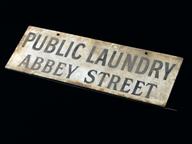

'Ventura' t-shirt worn by team working to develop the Ventura CPAP device
- Made:
- 2020 in Bangladesh




'Ventura' t-shirt as worn by the team working during the first UK national lockdown on the Ventura CPAP (Continuous Positive Airway Pressure) ventilation aid collaboratively developed by University College London (UCL), University College London Hospitals NHS Foundation Trust (UCLH), and the Mercedes Amg High Performance Powertrains team, for use in the COVID-19 pandemic, made in UK, 2020
During the fast paced development of the UCL Ventura CPAP device, the team realised they were running out of supplies including clothes. A member of the team was sent out to find something amongst the stores that remained open during the lockdown. They returned with several of these t-shirts. The Ventura logo on the t-shirt gave the device its name.
The UCL Ventura CPAP consists of three parts - the system flow generator, disposable circuit including tubing and an oxygen mask or hood and a reusable oxygen analyser. As the world faced challenges of supply and demand the team developed their own devices from scratch.
During the first wave of the COVID-19, opinion was split on which was the best technique to help people with COVID-19 in hospital breathe. Information from Italy and China through Prof Meryn Singer recommended Continuous Positive Airway Pressure (CPAP). However, only 12 stand alone CPAP devices were available across UCLH Trust. CPAP (Continuous positive airway pressure) pushes a steady flow of air oxygen into a person’s nose and mouth either through an oxygen mask or oxygen hood.
To help meet demand, a multidisciplinary team led by Professor Rebecca Shipley and Professor Tim Baker reverse engineered and improved an off patent device called Respironics WhisperFlow®. The UCL and UCLH team consisted of Singer, Prof David Lomas, Dr Tom Peach, Dr Tom Rushton, and Mr Peter Weston. Alongside colleagues, Andy Cowell, Ben Hodgkinson and Pierre Godof, from Mercedes-AMG High Performance Powertrains, the team took fewer than 100 hours from their initial meeting producing their first prototype. Ten days after their first meeting, the Mark I Ventura had regulatory approval from MHRA (Medicines and Healthcare products Regulatory Agency).
The team had to work in a bubble due to COVID-19 restrictions, often moving into hotels to protect their loved ones and colleagues, spending weeks away from home. For their work, the team were awarded the Royal Academy of Engineering’s President’s Special Award for Pandemic Services in 2021. Rebecca Shipley was awarded an OBE and Tim Baker a MBE for their work.
Details
- Category:
- Public Health & Hygiene
- Object Number:
- 2022-193
- Materials:
- cotton
- Measurements:
-
overall: 730 mm x 820 mm x 4 mm,
- type:
- t-shirt




